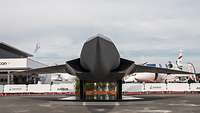The FCASFuture Combat Air System nations will strengthen their partnership during Pacific Skies
Indo-Pacific- Date:
- Reading time:
- 3 MIN


Germany, France, and Spain are the nations that are mutually developing the European weapon system of the future, the Future Combat Air System (FCASFuture Combat Air System). This summer, they will use the Pacific Skies international air force exercise to train together and coordinate their effective interaction within the Alliance even further.

A first demonstration model of the planned New Generation Fighter (NGF) was presented at the Paris Air Show in Le Bourget in 2019. As of today, it is not yet clear what the sixth-generation fighter aircraft will actually look like.
Bundeswehr/Jane SchmidtPilots of the three air forces will train combined air-to-air combat with their aircraft in three of the five exercises that form Pacific Skies, sometimes involving further nations as well. Arctic Defender will take place in Alaska in July, Pitch Black in Australia from mid-July to the beginning of August, and the Tarang Shakti Phase 1 exercise in India from early to mid-August.
Working, planning and flying together: This deepens the partnership of the three FCASFuture Combat Air System (Future Combat Air System) nations and contributes to the progress of the combined future project.
The FCASFuture Combat Air System (Future Combat Air System) project itself has now reached the demonstration phase as it is called. Germany and France began planning a combat aircraft in 2017. In 2019, Spain joined the project and the Defense Ministries of three nations signed a framework agreement on the mutual development of the FCASFuture Combat Air System (Future Combat Air System). In March 2023, the contract period between the industrial partners of the nations involved commenced. Common parameters and key technologies had to be developed, and numerous studies and research projects at different locations are required to ensure that the individual components of the complex cross-linked weapon system engage with one another and function well.
The intention is to have two demonstrators at the end of this phase: one for the New Generation Fighter (NGF) and one for the planned unmanned aerial vehicles, the remote carriers. Demonstrators can be compared to concept cars or disguised prototypes of the automobile industry. The demonstration aerial vehicles are expected to take off for the first time in 2028 or 2029.
This will be followed by a test phase in which all structures and systems will be tested, adapted and brought to perfection. Only then, it will be clear what the new European sixth-generation combat aircraft and its remote carriers will actually look like and when production will commence. It is planned that the FCASFuture Combat Air System (Future Combat Air System) will be introduced into service in 2040.

Less complicated than it seems to be: The new combat aircraft and its drones form the NGWSNext Generation Weapon System (Next Generation Weapon System) together. The combat cloud links them and all other aircraft of an air force. This is FCASFuture Combat Air System (Future Combat Air System). Army …
BundeswehrThis “system of systems” will thus be much more than the New Generation Fighter and its remote carriers alone. A combat cloud will ensure that all pieces of information available within the network are also made available in real time to all other systems participating in a mission – in the air, on the ground, at sea, or in cyberspace. This means that, for example, the current combat aircraft of the nations involved – the Eurofighter and Rafale aircraft – will also be integrated into the FCASFuture Combat Air System (Future Combat Air System) and will only be replaced by NGF step by step.
by Stefanie Pfingsten